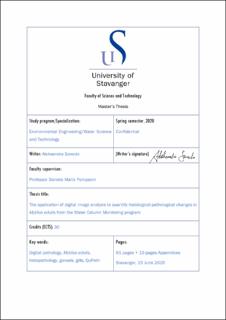| dc.description.abstract | Use of histopathology to identify changes in marine species in response to contaminants is a long-known practice. The suitability of histopathological biological markers in the assessment of marine environment quality derives from their relatively high ecological relevance, as alterations on tissue level are often irreversible. Also, affecting the physiology of an individual could impose a potential effect on the whole population. Visual assessment, traditionally used in the scoring of histological parameters, is prone to bias, which is a major disadvantage. The advances in image acquisition and digital image analysis over the last decades created a suitable, dynamically evolving environment for analysis of high-content histological images. Digital pathology, taking advantage of computer vision and the high potential for automation, could address the limitations persistent in manual scoring methodology. In this study, we propose the application of digital image analysis in performing analysis of histological parameters in genital and gill tissues of Mytilus edulis. Mussels were collected as a part of Water Column Monitoring (2017) program from the rig stations in various proximities to the offshore platforms in Tampen area. Using QuPath, an open-source digital analysis software, specifically designed to handle whole slide images, we developed a method for gender recognition in Hematoxylin & Eosin (H&E) colored slides with >97% success rate. We performed a comprehensive analysis of male genital tissue with emphasis on gonad area and cells in various stages of gametogenesis. The comparison of our results with the available scores from the manual assessment of gonadal status and spawning stage failed to replicate the original classification scores. The differences between groups were significant for a subset of parameters. Stemming from the small size and narrow diversity our study sample, the analysis was limited. Using slides stained with Alcian Blue – Periodic Acid-Schiff, we quantified mucus cells in gill tissue and performed classification of mucus cells according to the properties of the stain. The comparison of our results with the original scoring of the lesion “Abnormal mucus secretion” did not reach significance. The manual scoring of the lesion was performed on H&E colored slides, which might explain the lack of correlation with our results. Lastly, we investigated the potential correlations between mucus cell quantity and concentration of various contaminants determined in mussels as a part of WCM 2017 program. The study showed that digital pathology could be a viable approach for quantification of histological parameters in Mytilus edulis, especially when used with lesion-specific staining. In the study, results obtained by digital image analysis did not always reflect the visual scoring, which might be due to bias in visual scoring or limitations of developed digital methods. In order to fully benefit from digital pathology, broad expertise in digital image analysis and histopathology, as well as data mining should be brought together. | en_US |
